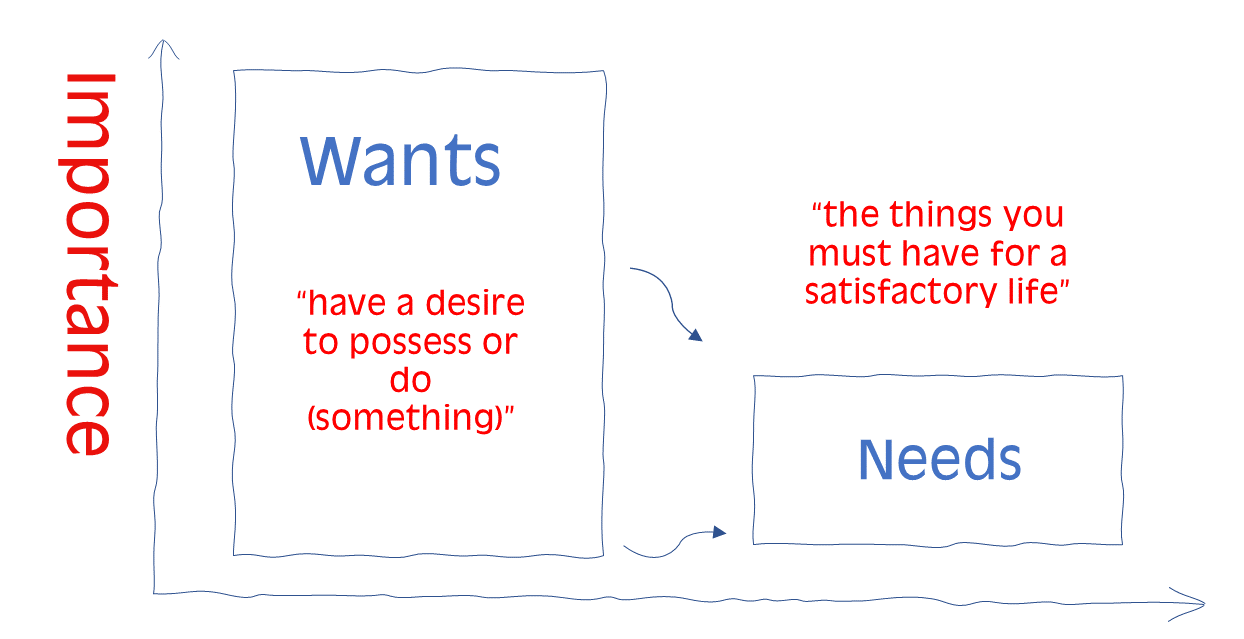
Getting product market fit
- 8 min read
You need to go to the gym. You want to look good. It’s the marketing 101 example of the difference of ‘Needs vs Wants’ that often gets overlooked in the journey of innovation. When exploring innovation ideas the rational rigour that underlies ‘needs’, the relative simplicity in explaining them and the tendency for non-marketer executives to overlook the distinction means that the insight is lost.

For innovators, the reason that the distinction is so important, is that you can develop a brilliant solution that perfectly solves a need but won’t get the time, or the attention, or the revenue from the target market.
We know that discussing 'wants' vs 'needs' can be simplistic and over-simplify the challenge of a given innovation. However, it's rare that an initial innovation idea is born 'fully formed'. There will be a need to challenge and shape it. We have found that wants and needs are a solid starting point when tackling the challenge of product market fit.
What is product market fit?
Product market fit describes the nirvana of having a product that ‘sells itself’. In essence the product clearly solves a problem and does so in a way that customers want to buy it.
In essence, you will know if you’ve got it – and there are a range of metrics that can help demonstrate this to stakeholders. For example from a number’s perspective, if over 40% of existing customers would be ‘very disappointed’ if they could no longer have access to the product (the Sean Ellis Test), you’ve got Product Market fit. If you can cover your cost of acquisition (CAC) within 12 months of onboarding a client, and the value of a customer over their lifetime with you (Customer Lifetime Value) is the 3x the cost of acquisition (David Skok’s test), then you’ve got product market fit.
Getting to a position where you have product market fit provides you with lower customer acquisition costs, increased cash-flow, and greater flexibility to address other challenges.
If you screw almost everything else up, you can still succeed. How else would you explain the success of a 25 year old running a billion dollar company. If the market demands your product and pulls it out of your hand.
You can’t trust customers in their articulation of wants and needs
So if product market fit is so crucial, can’t you go to your target market and ask them to describe their wants and needs? Well, yes and no. Yes, you should be researching your target market, doing deep dive interviews that give you insight to their challenges, how they address them, their priorities and their way of working.
However, in the words of Steve Jobs “People don't know what they want until you show it to them. That's why I never rely on market research. Our task is to read things that are not yet on the page.” Or James Dyson “You just can't ask people what they want and then go off and make it. People want to be surprised, to see something different. That's what's exciting about it: the total uncertainty when you launch a product; whether it's going to sell or not”.


A recent example
We have been working on a project that has set out to improve the way people manage their careers. Recognising that the best career choices happen when there is a fit between the individual and the organisation, and that the CV is a poor tool for describing who someone is, Higher has set out to provide way for candidates to explain their profile, demonstrate their strengths and increase their self-awareness.
Growth in the product was slow despite strong positive feedback. Deep dive interviews highlighted, however, that thinking about careers actually only happens around job transitions (preparing to move and then changing roles). During that process the priority is to see what roles are out there. Only with job options in hand is there an appetite to think about career and fit.
One thing we've seen from this project; you've got to really know the customer and build the 'whole solution'. Any effort required by the customer is friction. And friction undermines product market fit.
So how do you innovate to achieve product market fit?
The process to find product market fit is well established and straightforward: explore the problem and get a deep understanding of the 'job-to-be-done' for the customer. Develop the innovation to the minimum viable proposition (MVP), keeping record of key assumptions, and take it to market. Test the solution and test the route to market. Identify which assumptions you have made which aren’t correct and what changes need to be made. Make the changes. Rinse And Repeat.
The simplicity of the process hides the effort that is required in each of these steps and is one of the challenges in delivering successful innovation.
The 4 product market fit challenges for innovators
From our experience, there are 4 key challenges to bear in mind when planning and delivering the product market fit aspect of an innovation project:
Challenge 1: Getting to understand the target segments too late in the process
Many innovation projects start with some insight on how to solve a problem. Initial momentum quickly turns to the features and functionality required in a solution. There will be some discussion on target segmentation (i.e. who are the users, how do they solve the problem currently, what's in it for them) – but in reality, it takes a back seat. Later on in the process there will be further discussion on segments though this tends to be from a marketing communications standpoint. Deep understanding of how the customer engages with the product is then missing.
Challenge 2: Forgetting that the value proposition is multi-layered
An important early stage of development of an innovative product / service is the definition of the Value proposition – typically in the format of a 10k feet strapline. For example, the opportunity might start with a value proposition "Simple retail solutions for restaurants that increases tipping”. However, once the top-level value proposition is defined, the underlying value propositions (or value levers) need also to be considered. With the same example, the sub value propositions might include “Increased visibility of server”, “More engaging bills”, and “Increased tipping visibility”.
This will typically break down into a hierarchy which allows you to build a solid story. In a recent client project, discussions on the core value proposition led to 20 value levers being identified, and a more structured and coherent approach was developed to explaining the opportunity in a way that the target customers were more able to understand.
Challenge 3: Not budgeting enough time for Product Market fit development
There is rarely enough resource for an innovation project, and there is always huge pressure to deliver as soon as possible. The quote ‘fail fast, fail often” (implying frequent iterations to find success) has been adapted in many companies to “fail fast” – which denies the opportunity to find product market fit.
In innovation it's less that failing to prepare is preparing to fail (Benjamin Franklin), and more that preparing to fail fast is destined to fail.
In two recent projects, we have seen that there needed to be as much time spent in developing product market fit, as there was in developing the initial MVP (solution).
Challenge 4: Too much investment is made in the MVP on the assumption of success
Almost every innovation process is built around some concept of an MVP which has some core functionality / set of features that will solve the customer problem.
However, we have seen situations where the MVP has been architected for scalability that wasn't required. The idea of the MVP is to generate a product that gets seeded with target customers, and can be used to identify the changes required to enhance product market fit. It should be a valuable proposition, that customers will pay for. Investment in scalability should come when product market fit is found.
Conclusion
Thinking about product market fit at the start can save significant time and money as the project unfolds. Recognising that wants trump needs and understanding both perspectives is crucial. Preparing for iterations, and not over engineering your MVP can equally increase your odds of getting to product market fit sooner.
Take aways
Here are a set of questions to help trigger your thinking about getting product market fit:
Digital Divisor
We are a specialist innovation business with a unique way of delivering projects. If you have any questions, please get in touch. We'd love to hear from you.